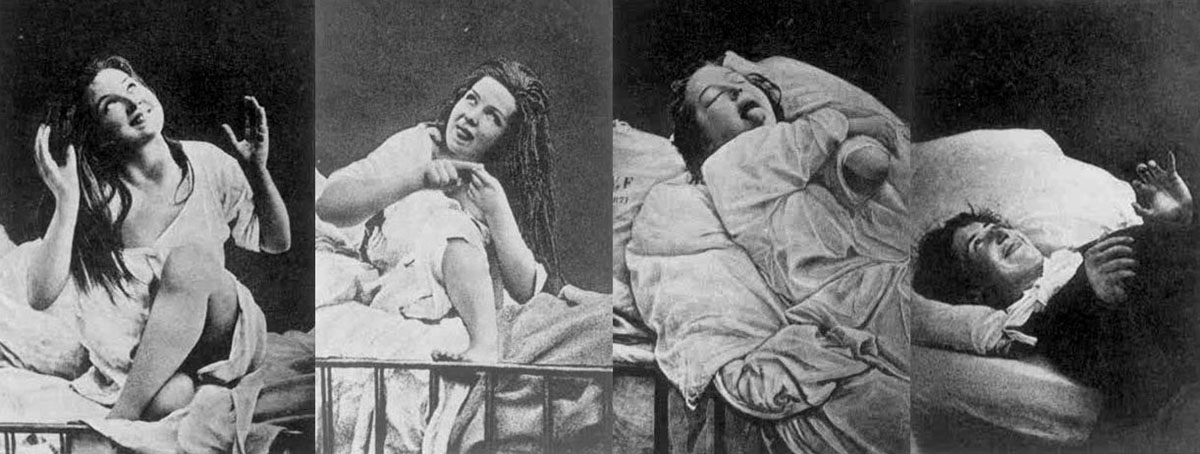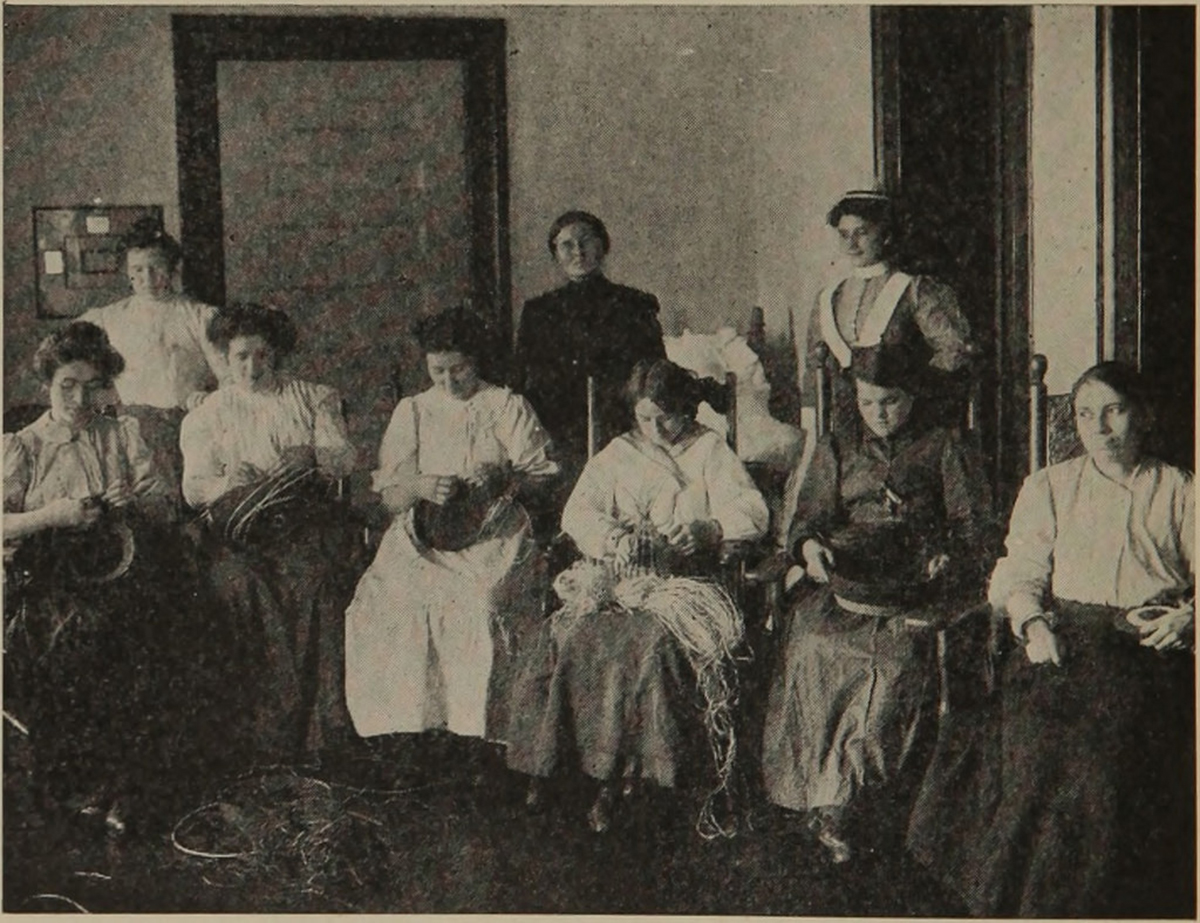Nowadays, when we think of mental health problems, we think of celebrities bearing their souls on National television, and clean counsellors' offices with beige couches and who listen intently to what you have to say.
However, it is only recently that that has been the case. The history of mental health care is scattered with electroshock, mind-bending addictive substances, and ice-water baths.
Just as the kind of treatments that people used to receive can make the bravest among us wince, the diagnoses that used to be made every day may make us gasp, as we remember how - as little as forty-years-ago - what was classed as a mental illness was predicated, not on biology, but on what was socially acceptable.
Female Hysteria
In the Victorian and Edwardian era, the role of a "real woman" was very clearly defined. She was a home-loving, demure creature; keeper of the hearth, lived for the daily hour with her children, excelled at quiet hobbies like needlepoint and playing the piano; she had no interest in politics or the world beyond her home, but knew how to keep her hands pretty.
Any woman who didn't fit that ideal "ladylike" mould risked being branded "hysterical". Indeed, there was a 75-page book of possible symptoms of Female Hysteria, with everything from nervousness, insomnia, and fluid retention to "a tendency to cause trouble" being branded as signs of the condition. Once the woman was declared to be suffering from Female Hysteria, her father or husband could have her locked away in an asylum. There was no appeal, no chance to prove she was sane.

Hysteria was originally considered to be caused by a "wandering womb". Doctors of the period assumed the womb would wander no more if it was removed, so many unwilling women were forced to have hysterectomies while incarcerated in asylums. Other common "therapies" performed on asylum patients were Oophorectomy (removal of the ovaries) and clitoridectomy (removal of the clitoris).
Another theory said Female Hysteria was caused by the retention of a "female sperm", which was supposed to mingle with the male sperm during climax. Of course, for a woman to enjoy sex was socially-unacceptable (and masturbation was a big no-no, too). So, doctors came up with the notion of pelvic massage. Basically, they would use oils and massage the clitoris until the patient had "hysterical paroxysm" (now, we'd call it an orgasm), which caused a rapid improvement in those pesky symptoms of hysteria. However, this caused terrible repetitive strain injury to the doctor's hands and wrists, whose waiting rooms swelled with respectable ladies, yearning to try the most socially-acceptable treatment for Female Hysteria.
It was the doctor's wrist ache that led to the invention of the vibrator, advertised in that most respectable catalogue, the 1903 Sears Catalogue, as "a delightful companion". But that's a story for another day.
More Historical Mental Health Diagnoses
Penis Envy
This is a Freudian theory that states all little girls realise they don't have a penis and immediately begin to covet their father's penis. They then spend the rest of their lives searching for a penis to call their own (in the form of sons and husbands). Freud assigned great power to the penis.
Due to having a penis, Freud believed men grow up noble and forthright, with a fully-developed superego (that's the part that Freud believed knew right from wrong). However - Freud said - due to the absence of a penis, women will lie, cheat and connive until they finally find a man to give them babies and moral guidance.
Yes, he did get paid to dole out this advice.
The "symptoms" Freud ascribed to penis envy were as varied and bizarre as the symptoms of Female Hysteria, and included lesbianism and masturbation.
However, Freud's patients were considerably luckier than those treated for Female Hysteria. While he considered his patients to be "reticent" and "dishonest" (Freud, 1905), he at least only talked to them, rather than cutting pieces out of them without their consent.

Monomania
At one time, monomania was the most fashionable diagnosis. That doesn't mean that people wanted to have it. It just means that it was so terribly easy to diagnose people and lock them away.
Monomania was classed as "partial insanity". People affected had the usual levels of intelligence, and behaved mostly normally, but they had a fixation with one idea or activity.
It was on these grounds that the greedy mother of Edward Davies had her son declared insane, and so took over his successful business in 1829. He had always had the same "unusual preoccupations", but now he was planning to take a wife. Suddenly, Mummy Dearest feared for her inheritance, and a mentally-sound - if eccentric - man was packed off to the asylum.
By the end of the 19th century, monomania was starting to fall out of favour. You'll be glad to know it had a happy ending for Edward, too. An appeal cleared his good name and restored him to his business.
Moral Insanity
The diagnosis of "Moral Insanity" springs out of the moral societies that formed in the early 19th century, which quickly gained popularity. Moral Insanity covered anything deemed hazardous to the social body, including larger things such as kleptomania and pyromania, to sex outside of marriage and being a lazy servant.
This is how one former housemaid, diagnosed with Moral Insanity, was described by her doctor: "lazy, mendacious, chasing after men, and prone to prostitution" (Rimke and Hunt, 2002).
In order to be diagnosed Morally Insane, a person had to have no intellectual disability, and no other sign of mental health problems. They just had to behave in a way that was socially unacceptable.
As was the fashion at the time, women were accused of being the greatest danger if diagnosed with Moral Insanity, for these would be the "mothers of the nation", who would produce inferior Libertine sons and wanton daughters, were they to be allowed to have any. Thus, the treatments for Moral Insanity included: compulsory sterilisation, permanent confinement, and laws to prevent the marriage of all those judged "morally-degenerate".
Homosexuality
Homosexuality was decriminalised in the UK (but only for men over 21) in 1967, however, it took until 1987 for homosexuality to be removed from the DSM (the Diagnostic and Statistical Manual of Mental Health Disorders) and until 1992 for the ICD (the International Classification of Diseases) to remove homosexuality from their list of mental health disorders (although the ICD still carries the diagnosis "ego-dystonic sexual orientation", where a person wishes their sexual orientation were different).
Today, someone with ego-dystonic sexual orientation can receive gay affirmative psychotherapy, to help them accept the sexual orientation they were born with.
However, forty years ago, things were very different.
Private "treatment" may have consisted of psychoanalysis, but more common treatments included aversion therapy, either with electroshock or Apomorphine (a drug that induced nausea and vomiting); shocks were administered to the lower leg, or the participants were given the drug if they didn't reach for photographs of members of the opposite sex. Other "treatments" included electroconvulsive therapy, religious counselling, oestrogen to reduce the libido, and being told to hire a prostitute or use a female friend for sexual intercourse (and so overcome the aversion it was assumed gay men must be experiencing).
Today, we've moved toward a more holistic and individualised view of mental health. And thank goodness for that.
- www.lib.uwo.ca/archives/virtualexhibits/londonasylum/hysteria.html
- www.ncbi.nlm.nih.gov/pmc/articles/PMC3480686/
- www.ncbi.nlm.nih.gov/pmc/articles/PMC539549
- www.sciencemuseum.org.uk/broughttolife/themes/menalhealthandillness/womanandpsychiatry
- www.psychologytoday.com/blog/all-about-sex/201303/hysteria-and-the-strange-history-vibrators
- Roach, Mary (2009). Bonk: the curious coupling of science and sex. New York: W.W. Norton & Co. p. 214.
- 19thct.com/2007/12/05/female-hysteria
- www.psychologytoday.com/blog/the-bejeezus-out-me/201605/sigmund-freud-had-penis-envy
- www.psychologytoday.com/blog/lunacy-and-mad-doctors/201304/gaslight-stories-the-mania-monomania
- www.psychologytoday.com/blog/hide-and-seek/201509/when-homosexuality-stopped-being-mental-disorder
- journals.sagepub.com/doi/pdf/10.1177/0952695102015001073
- www.livescience.com/54682-is-penis-envy-real.html
- psychistofwomen.umwblogs.org/sexuality/pre-kinsey/freud
- www.bmj.com/content/328/7437/427
- www.cvltnation.com/portraits-of-mania-the-inmates-of-west-riding-pauper-lunatic-asylum
- psychnews.psychiatryonline.org/doi/full/10.1176%2Fpn.36.10.0021
- psychology.ucdavis.edu/rainbow/html/facts_mental_health.html
- Photo courtesy of internetarchivebookimages: www.flickr.com/photos/internetarchivebookimages/14596981309/
- Photo courtesy of Wikimedia: commons.wikimedia.org/wiki/File:Hysteria.jpg
- Photo courtesy of Wikimedia: commons.wikimedia.org/wiki/File:Hysteria.jpg


Your thoughts on this